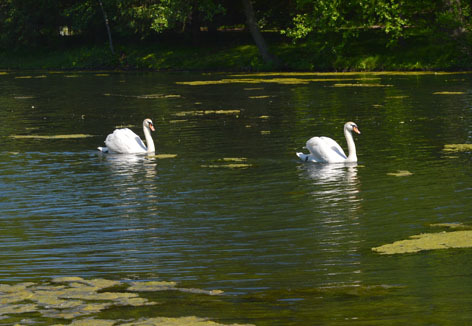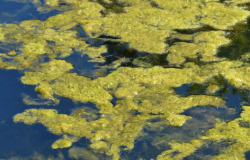
The filamentous algae on Lake LaVerne poses no threat to beloved residents Lancelot and Elaine. Photo by Bob Elbert.
It may not look pretty, but the floating gunk in Lake LaVerne is a sign of facility planning and management's recent switch to more sustainable and environmentally friendly care methods.
The filamentous algae grows at the bottom of the lake and thrives on oxygen and sunlight. Chris Strawhacker, landscape architect in FPM, said the 2.8-acre lake measures only about six feet at its deepest point, giving the algae ample sunlight to grow and bloom toward the surface. High levels of phosphorous, like those found in the soil and animal waste, also feed the algae growth.
"The algae is the result of the nutrient levels in the water; it's not really a problem for the lake," Strawhacker said. "It's just another aquatic plant in the lake. Unfortunately, it's pretty unsightly."

Filamentous algae. Photo by Bob Elbert.
Strawhacker said a long-term restoration plan that includes stabilizing the shoreline and increasing the lake depth will be needed to reduce the nutrient and algae levels.
Meanwhile, FPM's efforts have shifted toward limiting and controlling the amount of phosphorous that makes its way into the lake. For example, Les Lawson, FPM campus services manager, said crews no longer fertilize the grass areas surrounding the lake. They also conduct an annual application of aluminum sulfate, which adheres to the phosphorous and settles at the bottom of the lake.
"We're not necessarily trying to kill the algae," Strawhacker said. "We're trying to manage it in a way that's good for everything in the lake."
FPM works with the ISU Limnology Laboratory and Chris Filstrup, a postdoctoral research associate in ecology, evolution and organismal biology, to regularly test and track the lake's water quality. Filstrup and his team make recommendations for the optimal application times and how much of the treatment is needed. Lawson said the lab reports show that the approach over the last couple of years has been effective.
"The lake is pretty healthy," Lawson said. "We were doing some other things to kill the algae, and we really got into problems because we were messing with Mother Nature. Now we have a healthier lake -- we're getting more little creatures in there and it's looking better."
